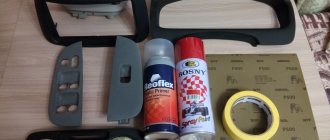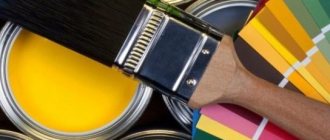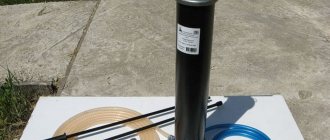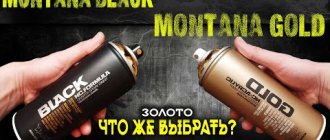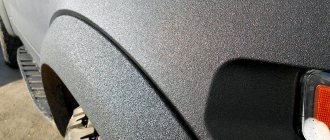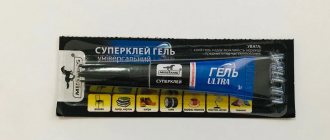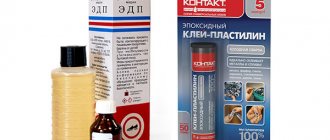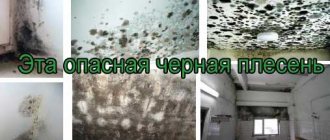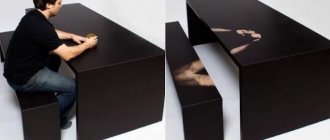Area and conditions of paint application
Polyurethane enamels are used when performing external work. This makes it possible to increase the stability of the structure of some rocks, if initially it cannot boast of stability. The varnish covers the stone with a thin protective film, so moisture no longer penetrates inside.
The place of application of polyurethane paints is also different. The external walls of the house allow the use of conventional types of compounds. Two-component options will be needed for those who seek to create unusual effects.
After drying, the surface acquires an unusual glossy tint. Chips and sudden changes in geometric parameters in this case become unacceptable. Solvent is used if desired. There are also compositions that create a matte finish. A very interesting effect is obtained; the solvent does not affect its production.
When applying such a coloring composition, it is necessary to adhere to a temperature of -10 to +30 degrees. You don't have to think about air humidity. Polyurethane enamel for concrete is easy to apply, even if the humidity level reaches 95 percent. The polyurethane coating itself tolerates temperatures from -40 to +150 degrees.
The surface to be painted must be primed first, otherwise it will be impossible to ensure paint adhesion at the proper level.
What to consider when choosing?
When faced with the problem of choosing a polyurethane coating, the buyer may get confused among the huge number of options. Paints for the same purpose differ in the types and proportions of components present in the mixture. This can significantly affect the technical characteristics.
For example, there are enamels adapted to low temperatures. Consequently, there is a difference in surface requirements and application conditions. Keep in mind that the shelf life of some one-component formulations does not exceed 6 months.
Application methods
Polyurethane compounds are divided into groups both according to their composition and according to the materials requiring processing. Application type can be:
- aerosol;
- using a brush or roller.
Aerosol spraying is most often used when processing metal products. Polyurethane paint for cars provides uniform coverage without streaks or smudges. It is also an excellent alternative to conventional balloon compositions due to its safety margin.
Polyurethane paint for concrete floors is evenly distributed using a roller. The result is a smooth and even coating. But polyurethane paints on wood are best applied with a brush.
Characteristics
When performing external finishing work, polyurethane enamel is used. This enamel increases the resistance of stone types, since it creates a durable film on its surface that prevents moisture from penetrating inside.
Polyurethane paints have a wide range of applications: from household use to road markings. Two-component compositions will help create interesting effects.
After the applied composition dries, an attractive gloss appears. Unfortunately, the glossy coating emphasizes all the roughness and unevenness, so the surface must be brought to perfect smoothness in advance. There are also enamels that create a matte surface.
The painting procedure is best carried out at temperatures from minus 10 to plus 30. Air humidity does not play any role. The enamel is well applied to concrete even at a humidity close to 95%. The coating itself tolerates temperatures from minus 40 to plus 150. To get good paint adhesion, you need to prime the surface.
Polyurethane paints can be classified according to their composition and the materials for which they are intended. You can apply the paint using a brush or roller, or you can also purchase paint in a spray can.
Metal products are usually spray painted. This method of painting cars allows you to get a uniform color without drips or streaks. Concrete floors are easier to paint with a roller, but wooden surfaces are easier to paint with a brush. Different forms of release of the composition facilitate the task of painting a particular object.
Polyurethane paints are very versatile and are suitable for different types of materials. A primer is a must. This is especially true for metal surfaces.
Wooden surfaces do not need to be primed, but be sure to dry them well. Wood tends to absorb everything, so not a single layer is required. Wood paint is intended mainly for furniture and furniture production.
Those who do not know how or do not want to bother with leveling layers of paint can purchase a self-leveling version of the composition. After application, tension is formed, which ensures uniform spreading of the paint, eliminating the formation of unevenness. The method of application does not matter.
What surfaces can be painted?
The materials that require processing are also different. Polyurethane paints are suitable for wood, metal and stone. It is these surfaces that most often require additional protection from external factors. The main thing to remember is the need to prime. This is especially true for metal surfaces. But sometimes floor paint for concrete falls under this rule.
And wood requires high-quality drying. In this case, you can do without a primer. At the same time, the material itself is able to absorb any compounds that are applied to it. Therefore, it is necessary to use several layers; one is not enough.
Polyurethane enamels are fully compatible with stone and adhere well to such a surface. Therefore, no primer is required in this case.
Sometimes buyers simply do not have the time to level a layer of paint with maximum accuracy, or they simply do not have the desire to do such work. Then it’s easier to use paint that levels itself.
Immediately after applying such material, so-called tension appears on the surface. It does not matter whether a roller or other device was used during application. Thanks to the tension, the paint spreads easily and all irregularities disappear.
In the video: polyurethane coating of a concrete floor.
Review of manufacturers
Finding high-quality polyurethane paint is not difficult. There are many well-known manufacturers on the market.
- "Teohim" - offers compositions for concrete and metal surfaces. It even produces food paint, which is harmless in contact with water and food products.
- LLC "TD KRASBYT" - offers one- and two-component alkyd-urethane mixtures.
- JSC "ALP ENAMEL" - offers one- and two-component paints. Feature – high adhesion even to corrosive metal.
- Sikkens Redox - produces compounds that are especially resistant to sea water and the atmosphere of the sea coast.
Types of polyurethane paints
There are several types of polyurethane paints on the market. For their manufacture, complex polymers are used, including high-quality polyurethane. There are also several brands, usually everyone knows them. Therefore, it is difficult to make a wrong choice. The solvent is often included initially.
Based on organic solvents
This is a common type of coloring composition, but the main modifier is polyurethane. These materials are one-component. But a couple more components are added to polyurethane: a coloring pigment, a solvent (also known as a thinner). The role of the latter is played by xylene or toluene. Under the influence of atmospheric moisture, processes such as hardening and polymerization occur. Moisture itself reacts with the components that make up the paint.
If the air in the room is too dry, the composition will not set. To dry polyurethane surfaces, it is generally prohibited to use air at too high a temperature. The higher the humidity level, the longer it will take to dry.
After application, the paint gains strength after at least 48 hours. Only after this the coating becomes completely waterproof. In addition, properties such as resistance to aggressive environments and wear resistance appear. This is also different from concrete paint.
Water-dispersed compositions
These materials are also considered one-component, but the place of the solvent for polyurethane compounds is taken by ordinary water. When painting, such paints are harmless. There is no toxic or simply unpleasant odor. In an aqueous environment, other elements of the material are distributed evenly, after which a so-called stable dispersion is formed.
When the water evaporates, the components seem to stick together. After this, they are finally united into a single whole. The result is a transparent thin film, which is endowed with both protective and decorative properties. The solvent component does not affect them.
The presence of water in the composition makes the paint freeze easily at low temperatures. If the paint is defrosted, it will be able to perform its functions, but the technical characteristics will noticeably decrease.
This option of polyurethane paints is excellent for rooms where the humidity level is constantly high. If you need to cover stucco molding or baseboards, then water-dispersive compositions are also suitable. They are distinguished by a high level of elasticity and do not crack even after bending decorative parts.
Alkyd-urethane options
This group includes polyurethane enamel for metal; car paint is no exception. These types of materials consist of the following components:
- pigments;
- solvent;
- driers that accelerate drying;
- alkyd-urethane varnish.
Other components are also included that help improve certain characteristics. No metal enamel is complete without their addition.
Polyurethane paint allows you to create a special film on the surface with increased protective and decorative properties. The degree of gloss along with the texture is determined only by the buyer, depending on preferences in a particular case. The material is suitable for work both indoors and outdoors.
This type of paint is resistant to temperatures in the range from -50 to +50 degrees.
Other positive qualities include:
- abrasion resistance;
- easy application using a roller;
- drying, which takes only a couple of hours;
- anti-corrosion protection if a metal surface is treated.
Features of two-component paints
Most often, polyurethane compounds are sold in two separate containers. One of them contains a hardener, and the other contains a resin. This type of paint can also be produced for concrete. This separation of components has its advantages:
- The ability to obtain a durable, wear-resistant coating. The characteristics are much better than those of standard formulations.
- Humidity does not affect processes such as curing and polymerization.
- It is easy to prepare the solution at once, in the required quantity. With further use, the remaining part does not lose its qualities.
A material such as acrylic paint is perfect for surfaces that are constantly exposed to negative environmental influences. There is additional protection against any acids along with solvents and alkalis. Sea and running water will also not be harmful to the composition. A construction mixer is used to mix the two paint components.
Options for applying polyurethane paint (2 videos)
Various products (26 photos)
Compound
Paint of this category is notable for the fact that it creates a strong layer on the surface being treated, protecting the material from damage. The paint is based on polymers and a homogeneous mixture of hardeners and dyes. Each element in the paint contributes to the formation of a durable, moisture-resistant coating.
Often this group of paints is sold in two separate containers, one of which contains the resin, and the other contains the hardener.
Two-component paint has advantages compared to one-component paint:
- more positive reviews than regular paint;
- moisture resistance;
- the ability to prepare the solution in portions, which ensures economical consumption of finishing material.
Polyurethane paint is suitable for covering areas exposed to destructive environmental influences. Water, acids and alkalis will not harm the coating.
